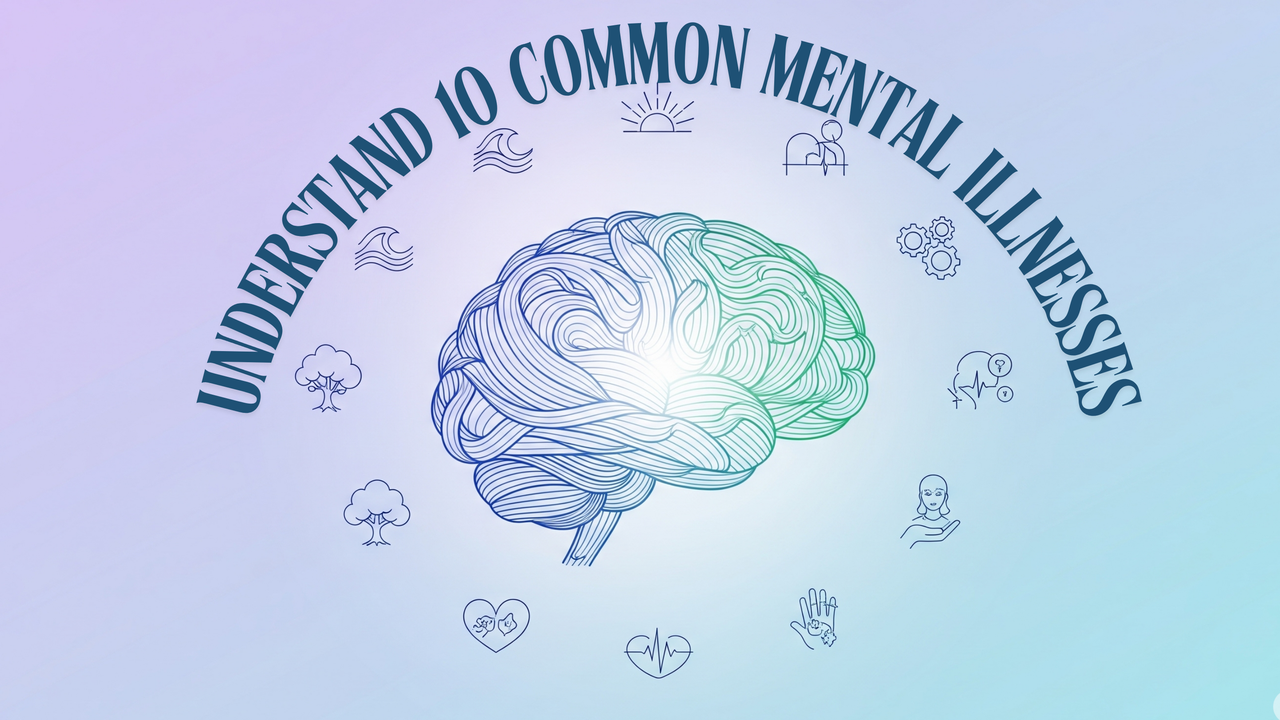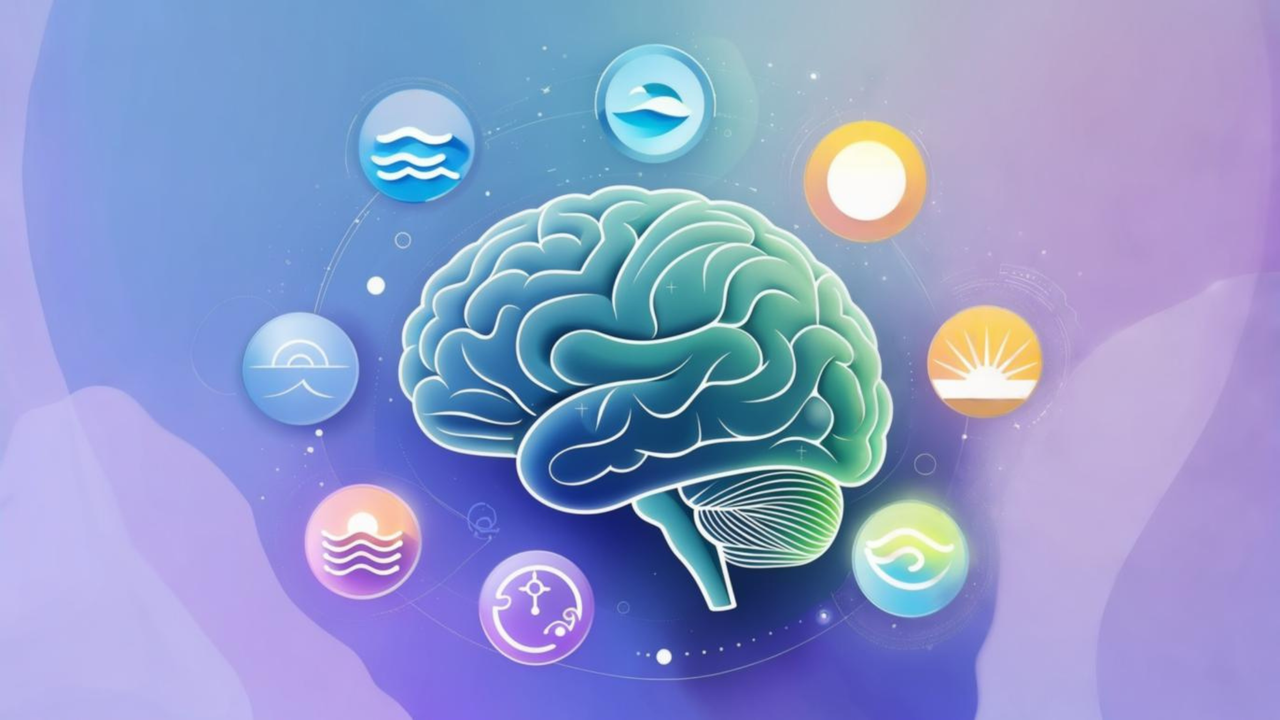Just like physical health, mental well-being deserves attention and care—but it’s frequently overlooked or misinterpreted. Many people struggle with mental health conditions in silence due to stigma or a lack of awareness. Understanding common mental illnesses is the first step toward fostering a more compassionate society and encouraging individuals to seek the help they deserve.
This article aims to shed light on 10 common mental illnesses, providing clear descriptions, typical symptoms, and emphasizing that these are treatable conditions.
 |
| 10 COMMON MENTAL ILLNESSES |
It's crucial to remember that a mental illness is not a character flaw or a sign of weakness. It's a health condition that affects your thoughts, feelings, and behaviors, often stemming from a complex interplay of genetic, biological, psychological, and environmental factors. With the right support and treatment, recovery and improved well-being are absolutely possible.
What Are Common Mental Illnesses?
Mental disorders affect millions worldwide, impacting daily life, relationships, and overall quality of life. Recognizing the signs and symptoms is vital for early intervention and effective management. Let's explore 10 common mental illnesses that individuals frequently encounter.
1. Depression (Major Depressive Disorder)
Depression is more than just feeling sad; it's a persistent mood disorder that causes a loss of interest in activities, significant changes in appetite or sleep patterns, and feelings of worthlessness or guilt. It can profoundly affect how you feel, think, and behave, leading to a variety of emotional and physical problems.
Common Symptoms:
Persistent sadness, anxiety, or "empty" mood
Losing interest or joy in hobbies and activities you once loved is a common sign of emotional distress, especially in conditions like depression.
Changes in appetite or weight
Sleep disturbances (insomnia or oversleeping)
Loss of energy or increased fatigue
Feelings of worthlessness or guilt
Difficulty thinking, concentrating, or making decisions
Thoughts of death or self-harm
Causes/Risk Factors: Genetics, brain chemistry imbalances, trauma, stress, and certain medical conditions can contribute to depression. Fortunately, with the right combination of therapy and medication, recovery is not only possible—it’s highly achievable.
2. Anxiety Disorders (Generalized Anxiety Disorder, Panic Disorder, Phobias)
Anxiety disorders are a group of conditions defined by ongoing, overwhelming feelings of fear and anxiety that can interfere with daily life. Unlike normal, fleeting anxiety, these conditions involve excessive, persistent worry and fear that interfere with daily life. This category includes Generalized Anxiety Disorder (GAD), Panic Disorder, and various Phobias.
Common Symptoms:
Excessive worrying or fear
Restlessness or feeling on edge
Fatigue
Difficulty concentrating
Irritability
Muscle tension
Sleep problems
Panic attacks involve sudden, overwhelming fear along with physical symptoms like a pounding heart, trouble breathing, and lightheadedness—common in those with Panic Disorder.
Causes/Risk Factors: Genetics, brain chemistry, personality traits, and life experiences like trauma can play a role. Treatment often involves psychotherapy, medication, or stress management techniques.
3. Bipolar Disorder
Bipolar disorder is a brain disorder that causes unusual shifts in mood, energy, activity levels, concentration, and the ability to carry out day-to-day tasks. These mood swings range from periods of high energy and elevated mood (mania or hypomania) to periods of depression.
Common Symptoms:
Manic Episodes: Increased energy, decreased need for sleep, racing thoughts, extreme irritability, impulsive behavior, grandiosity.
Depressive Episodes: Symptoms similar to major depression, including profound sadness, fatigue, and loss of interest.
Causes/Risk Factors: A combination of genetic factors, altered brain structure, and environmental factors are believed to contribute. It's a lifelong condition typically managed with mood stabilizers and psychotherapy.
4. Schizophrenia
Schizophrenia is a chronic and multifaceted mental health disorder that alters how individuals perceive reality, often affecting their thinking, emotional expression, and behavior. Individuals may experience a break from reality, which can be deeply unsettling for both them and their loved ones.
Common Symptoms:
Hallucinations: Hearing, seeing, or feeling things that aren't real.
Delusions: False beliefs not based in reality.
Disorganized thinking and speech: Difficulty organizing thoughts or speaking clearly.
Negative symptoms of schizophrenia include a reduced ability to experience pleasure, social withdrawal, and difficulty initiating or sustaining daily activities.
Causes/Risk Factors: Genetics, brain chemistry, environmental factors, and complications during pregnancy/birth can increase risk. Treatment typically involves antipsychotic medications and psychotherapy.
5. Obsessive-Compulsive Disorder (OCD)
Obsessive-Compulsive Disorder (OCD) involves recurring, intrusive thoughts and fears—known as obsessions—that drive individuals to perform repetitive behaviors or mental rituals, called compulsions, in an effort to ease their anxiety. When obsessions and compulsions take over, they can interfere with everyday life and cause a great deal of stress and frustration.
Common Symptoms:
Obsessions: Persistent, intrusive thoughts, urges, or images (e.g., fear of germs, need for symmetry).
Compulsions: Repetitive behaviors or mental acts performed to reduce anxiety or prevent a dreaded event (e.g., excessive handwashing, checking, counting).
Causes/Risk Factors: Genetic factors, brain structure, and learning experiences are thought to contribute. Therapy (especially exposure and response prevention) and medication are common treatments.
 |
| BEYOND THE BLUES |
6. Post-Traumatic Stress Disorder (PTSD)
Post-Traumatic Stress Disorder (PTSD) is a mental health condition that can arise after experiencing or witnessing a traumatic event, such as violence, accidents, or natural disasters. The trauma can be physical, emotional, or psychological, and includes events like combat, natural disasters, accidents, or assault.
Common Symptoms:
Re-experiencing: Flashbacks, nightmares, intrusive thoughts about the event.
Avoidance symptoms may include deliberately staying away from environments, individuals, or situations that evoke memories of the traumatic experience.
Negative changes in thoughts and mood: Difficulty remembering aspects of the trauma, negative beliefs about oneself or the world, feelings of detachment.
Arousal and reactivity: Irritability, difficulty sleeping, hypervigilance, exaggerated startle response.
Causes/Risk Factors: Experiencing or witnessing trauma is the direct cause. Therapy (like Cognitive Behavioral Therapy and EMDR) and medication are effective treatments.
7. Eating Disorders: Anorexia, Bulimia, and Binge Eating Disorder
Eating disorders are complex psychological conditions that involve deeply disrupted eating patterns and distressing thoughts or emotions related to food and body image. These disorders can lead to serious health complications, both mentally and physically. The most recognized forms include Anorexia Nervosa, Bulimia Nervosa, and Binge Eating Disorder.
Common Symptoms:
Anorexia Nervosa: Restricting food intake, intense fear of gaining weight, distorted body image.
Bulimia Nervosa: Recurrent episodes of binge eating followed by compensatory behaviors like purging (vomiting, laxative misuse), excessive exercise.
Binge Eating Disorder: Recurrent episodes of eating large amounts of food, often quickly and to the point of discomfort, without compensatory behaviors.
Causes/Risk Factors: A combination of genetic, psychological, and sociocultural factors contribute. Effective treatment typically relies on a collaborative care model, bringing together medical professionals, mental health specialists, and nutrition experts to support comprehensive recovery.
8. Borderline Personality Disorder (BPD)
Borderline Personality Disorder (BPD) is a deeply rooted psychological condition that shapes how a person views themselves and interacts with others, often leading to intense emotional shifts and unstable relationships. It often leads to intense emotional instability, impulsive behaviors, and difficulties maintaining stable relationships and a consistent self-image.
Common Symptoms:
Intense fear of abandonment
Unstable and intense relationships
Rapid mood swings
Impulsive and often dangerous behavior (e.g., reckless driving, substance abuse, binge eating)
Self-harming behavior or suicidal threats
Chronic feelings of emptiness
Intense anger or difficulty controlling anger
Stress-related paranoia or dissociation
Causes/Risk Factors: Genetics, brain abnormalities, and childhood trauma are often associated with BPD. Psychotherapy, particularly Dialectical Behavior Therapy (DBT), is highly effective.
9. Attention-Deficit/Hyperactivity Disorder (ADHD)
Attention-Deficit/Hyperactivity Disorder (ADHD) is a neurodevelopmental disorder typically diagnosed in childhood, though it can persist into adulthood. It's characterized by difficulty paying attention, excessive activity, and impulsive behavior.
Common Symptoms:
Inattention: Difficulty focusing, easily distracted, forgetfulness, struggling to organize tasks.
Hyperactivity: Fidgeting, restlessness, difficulty staying seated, excessive talking.
Impulsivity may present as speaking out of turn, struggling to wait patiently, or engaging in actions without considering the consequences—behaviors that can disrupt daily interactions and decision-making.
Causes/Risk Factors: Genetic factors are significant, along with brain structure differences and environmental factors like exposure to toxins in childhood. Treatment often includes medication, behavioral therapy, and lifestyle adjustments.
10. Social Anxiety Disorder (Social Phobia)
Social Anxiety Disorder (Social Phobia) is a common type of anxiety disorder. This condition is marked by a deep, ongoing fear of scrutiny or negative evaluation by others, often prompting individuals to withdraw from social settings to avoid discomfort or embarrassment. The fear can be so severe that it interferes with work, school, and other daily activities.
Common Symptoms:
Intense fear of social situations
Avoidance of social gatherings
In social situations, individuals may experience physical signs of anxiety such as facial flushing, excessive perspiration, shaking, or a racing heartbeat—responses triggered by heightened fear of judgment or embarrassment.
Individuals may experience prolonged anticipatory anxiety, spending days or even weeks consumed by worry about an upcoming social interaction.
Fear of humiliation or embarrassment
Difficulty making eye contact
Causes/Risk Factors: Genetic predisposition, brain structure, and learned behaviors from negative social experiences can contribute. Therapy (especially cognitive behavioral therapy) and medication are effective treatments.
Seeking Support and Breaking the Stigma
Understanding these 10 common mental illnesses is crucial, but equally important is recognizing that help is available and effective. Mental health conditions are not a sign of weakness, and seeking professional support is a sign of strength. Therapists, psychiatrists, and other mental health professionals can provide accurate diagnoses and tailored treatment plans, including psychotherapy, medication, or a combination.
If you or someone close to you is facing mental health challenges, don’t hesitate to seek support - help is available, and healing is possible. Talk to a trusted friend or family member, contact your primary care physician, or seek out mental health resources in your community. Websites like the National Alliance on Mental Illness (NAMI) or the Substance Abuse and Mental Health Services Administration (SAMHSA) or the Mindzo.us offer valuable information and support.
By openly discussing mental health, we can break down the stigma and create a supportive environment where everyone feels comfortable seeking the care they need to thrive.

Comments
Post a Comment